|
THE INNOCENTS ABROAD AGAIN
Notes and pictures from a Journey to 'Greater Scandinavia' -
Finland, Sweden, Norway and Iceland - Summer of 2008
Pictures
by George and Maryo, text by
George
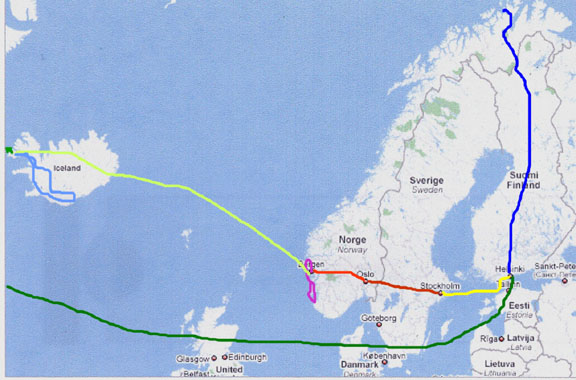
This was our journey, roughly: We flew
to Helsinki (green line)
although we were actually routed through Amsterdam after a flight
problem. We had a couple days in Helsinki, then took the train north to
Rovaniemi on the Arctic Circle, and rented a car to drive around Sapmi
(formerly Lapland) and the home of the Sami people (formerly Lapps), then back to Helsinki by train
again (blue line). Then we
took an eleven-story ferry from Helsinki to Stockholm (yellow line), where we were for a
couple days. Then a train to Bergen, Norway, over the Scandinavian
ridge, by way of Oslo (orange line).
We spent a couple days Bergen, then a couple more driving
around the coastal fjord country (pink
line). Then we flew to Iceland (light green line), where we rented
a car and spent several days touristing around Iceland (light blue line). Then home to
Colorado. That's the broad overview - now to the journey itself....
It’s what we call a
“vacation” – but I’ve never liked the
sound of that word. I like the Upper Gunnison Valley; why would I want
to vacate? Call it
instead a scouting expedition, looking for examples of intelligent life
on
earth, ideas and observations that might be worth trying. We were
tourists all the way, and it's interesting seeing that from the other
side of the tourist economy.
What follows is divided into five
"pages"; you can click on any of these places to go straight to that
part of the trip:
I've tried to make this
something other than just a travelogue, the reflections instead of a
stranger in a strange land. But I won't be offended if you just decide
to skim down for the pictures.... - G
NOTES IN TRANSIT, NEW WORLD TO OLD
Flying toward tomorrow in a
darkened quiet plane, all of us sitting eight abreast, facing forward,
theater-style, but the only show was the little screen on the seatback
in front
that told you where you were with respect to where you’d been and
where you
were going, and also some “when” info both backward and
forward – the time in Minneapolis,
time in Amsterdam – seven hours later there, well into tomorrow
by midnight
Colorado time, a day half gone by the time we got there. Ground speed,
605 mph.
Tailwind 145 mph. Temperature -65 degrees C. Altitude 35,700 feet.
There in the
plane, there was no sense of motion most of the night; except when the
145-mph
tailwind tried to push us around a bit, we might have been sitting in a
room
somewhere with a slightly noisy air-conditioner. Eerie, when you know
intellectually that you are hurtling through the atmosphere at 600
miles per
hour, in an environment inhospitable to carbon-based life, with nothing
between
you and that environment but a thin metal skin…. I don’t
really like to fly
because I find it so hard to not think about such things. To get on an
airplane
is an act of faith that works better for people more given to believing
than
thinking.
A strange little old man from North
Dakota was sitting next
to Maryo, on his way to visit his son in Germany: a couple times during
the
night, he took out a mouth harp and played quietly for a bit.
NOTES FROM THE AMSTERDAM AIRPORT: Coming
into the airport,
the altitude displayed on the screen on the plane was one foot. Since
this is
where “reclamation” means taking water off the land –
basically the ocean –
rather than putting it on the land, I guess they must have looked for a
high
point to get that much altitude; in our controlled fall out of the sky
onto the
runway, the scenery was green fields and blue-green ocean separated by
a an
unnaturally regular shoreline, a line of levees, or I guess dikes as
they call
them here. A lot of this area has been literally reclaimed from the
sea, and
the canals that Hans Brinker skated on are carrying water away from the
land,
not onto it like on our West.
Goethe’s Faust found some of
his saving grace, his
meaningful work, reclaiming this land from the sea. He saw it as
enabling human
activity, “humanizing” the earth; probably a lot of us
today would oppose it as
environmentally destructive, “denaturing” nature,
converting it from random
Darwinian evolution to the kind of Lamarckian cultural evolution,
industriousness leading to industry that eventually led to an airport
in
Amsterdam to which travelers who’d meant to go to Helsinki via
Reykjavik could
be diverted through instead, no problem, a landscape which one could
look down
on from
heights Faust would probably also have found interesting but still not
enough,
not quite enough….
FINLAND
Writing from a balcony on the ninth floor of
the Palace
Hotel in Helsinki, overlooking Helsinki’s South Harbor and the
site of the
biggest “Farmer’s Market” I’ve ever seen.
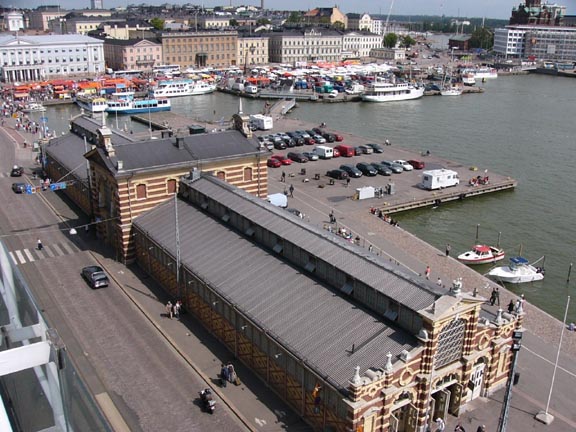
The “Harbor Market” is
actually in two parts: one part is the big old (1889) ornate brick
building
that looks more like a temple than a shelter for farmers and bakers and
cheese
makers selling what they raise and make. It’s kind of a temple to
the idea of
the small food producer.
The rest of the Harbor Market is the
three
acres or so of tents
and lean-tos and other shelters in the background, along with a few
boats tied up in the harbor, with everything from fresh produce and
fresh
fish to cooked produce and cooked fish to cut flowers to potted plants
to arts
and crafts to pure art and “Scandinavian design.” Maryo
remembers it from when
she and her family lived in this neighborhood 50 years ago, and who
knows how
long it had been going on then. Probably once it – along with a
couple three
others scattered around the city – once fed a lot of the city.
Now there are
(I’m not making this up) “City Markets” throughout
the
city providing all the
industrial groceries with which we are familiar. But this
farmers’
market is
still crowded even on weekdays. Maybe it takes half a century, a
century, to
make something like this actually become part of people’s lives.
A couple more market pictures - one
inside the "temple to local food production" (note the ornate
woodwork), and the other featuring some street musicians in front of a
stand....
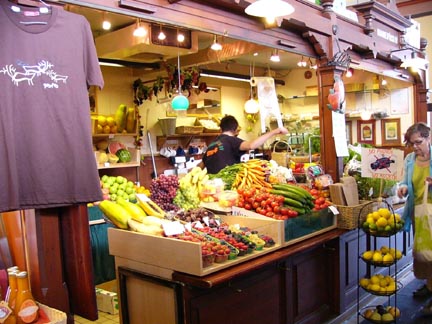 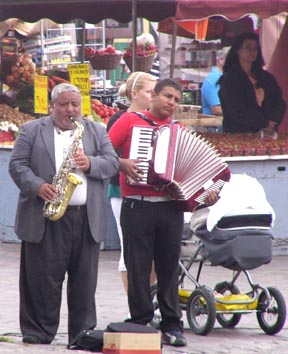
One thing we quickly discovered, and managed
to fit into
pretty easily, is the “moveable parade” that Helsinki is. A
couple blocks from
our hotel was a four-block park called the “Esplanade.”
This is basically a
people-watching site. All the restaurant businesses across the street
from the
park have outside areas, and the chairs in these areas are consciously
set up
for people-watching – all the chairs face the street. If you go
there to talk
with someone, you don’t sit across the table from that person;
you sit beside
them so both of you can watch the passing parade as you talk.
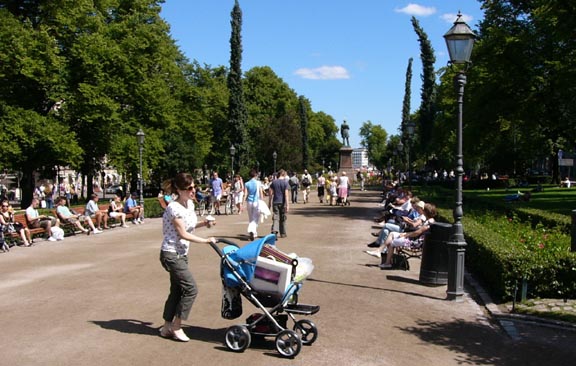
And the parade itself is a miracle of
diversity. The
Esplanade was originally just for the upper crust, the high society
people, but
it has totally democratized. Now, in the space of half an hour or so,
you will
see go by… Old people in suits and dresses. Young punky people
wearing pounds
of metal and torn stockings. Maybe a dozen Buddhist monks with drum and
wind
instrument. Maybe a dozen young guys all wearing devil’s horns
and some with
their faces painted red. You imagine or dream it: wait long enough and
it will
eventually pass by. And after a time of watching the
passing
parade, everyone
gets up and becomes part of the passing parade, while others sit it out
for a
cup and watch.
Our favorite place for watching is a
café called Kapelli (below),
where your morning coffee can, if you
dwaddle well enough,
segue into your afternoon beer. Karhu, the beer of bears, a bear of
beer. But
they don’t fill your pint! For whatever reason or custom, they
only fill the
glass to about two inches from the top. Hmmpfh. Some things are
definitely
better in America.

Like all great cities, Helsinki
is a walkabout museum, with a lot of statuary to illustrate the
history you are walking through. And every statue seems to be guarded
by a pigeon. Here's J. L. Runeberg, Finland's national poet - about
whom, more below. The most interesting part of this statue - other than
the guard pigeon - is the woman at the base of the statue - "The Spirit
of Finland." If the Russians had taken a good look at her before trying
in invade Finland in 1939, they might have thought better of it....
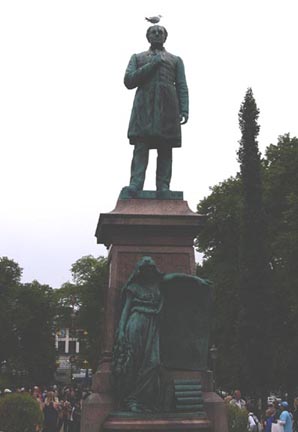 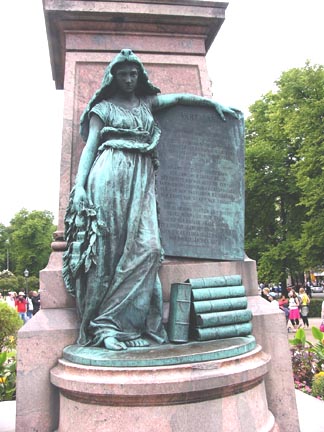
Helsinki is a lovely city, very human in its
scale. The
biggest, tallest buildings are still its churches, homage to gods other
than
the Mammon to whom we build our temples in America. Not that Finland is
a very
religious place: church attendance is pretty low according to the
guidebooks.
If they worship anything, most Finns would seem to do homage to the
idea of the
livable society. They are trying to make the city work for everyone.
But the churches are very impressive. Here are the huge Lutheran
and Russian Orthodox Churches....
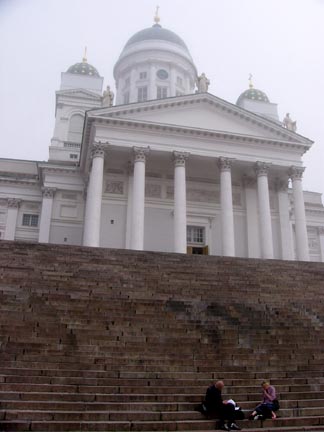
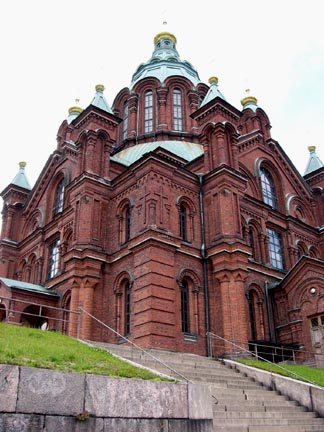
On of the great things
about Helsinki - they never allowed the
benevolent
corporations of oil-based privatization to eliminate their
public-transit
electric trolley system, the way most of the American cities did; the
trolleys
that Maryo remembers from when she was here in 1959 are still here, and
they
run so regularly around the downtown that you don’t even have to
think about a
schedule. We also got the sense that you don’t really even have
to worry about
a ticket. We bought all-day tourist tickets for the entire public
transit
system – on and off whenever you pleased, which was good since we
usually found
ourselves on the wrong trolley and needing to backtrack and start over.
And
most of the people, when they got on the trolley, scanned their
long-term
passes on a kind of pass reader. But we never saw anyone actually
checking
tickets on the trolleys, and probably we could have just ridden free
all day. I
expect there are people who do. But I would also guess that most of
those who
do, do so out of need rather than a sense of getting away with
something, and
the rest of the people buy tickets or passes because they believe in
the
system; to not do so would be violating some essential trust or
contract. This
is just the way Helsinki people seem to be.
The trolley system that
serves the main
metro area is
augmented by bus lines to remoter places that seem to run every half
hour or
so. That’s the ideal anyway, and maybe even the usual practice.
But lest this
sound too perfect - we had a couple interesting public transit moments.
Twice
we tried to get to an outdoor museum a little ways beyond the city
– “the 24
bus,” we saw from the handy-dandy public transit guide we picked
up at one of
their many tourist-information sites. The first day we tried, we got
off the
bus at the Sibelius Monument
to check that out, then went back to the same stop, where we joined
three other
people waiting for the 24. The bus came along – and just passed
us up! Swerved
in toward the bus stop but didn’t even slow down, just went on
down the street.
Five people looking slackjawed at each other: did that really happen?
So the next day we tried again. We got on
the 24 at the end
of the Esplanade, showed our one-day passes at the driver, who
semi-studiously
ignored us. Okay, we thought, and went and sat down. The driver then
disconnected his money box and left the bus. Okay, we thought, and
meanwhile
people were climbing on the bus, taking seats. We sat and we sat. The
time came
for the bus to leave, and the driver wasn’t back, n or was a
substitute driver
there. We sat some more, but by now low conversations were starting up.
Eventually, another 24 pulled in behind us – the next bus running
that route.
Everyone shrugged, got up and left the driverless bus, and went back to
the new
one – everyone except Maryo and me; we decided we weren’t
meant, for whatever
reason, to visit that museum and went back to getting lost on the
trolleys. Two
hours later we went by that bus stop and the empty, driverless 24 was
still
sitting there, door open, a few new people sitting inside probably
thinking
that the driver would be back in a minute, ready to run the
route….
Here's Maryo with one of the old-style
trolleys she remembered from when she was 11 in Helsinki.
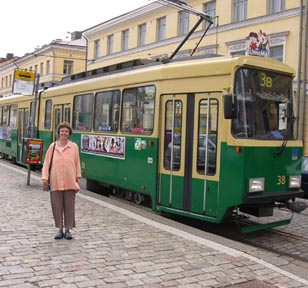

The picture on the right is the
Sibelius Memorial - a beautiful abstract array of metal pipes that, on
a windy day, probably sounds like a Sibelius symphony. It was a little
too abstract for the Finns, though, so the artist had to add the bust
of Sibelius that's at the bottom on the right. The rock is natural, and
lies not very far beneath the surface everywhere in Finland - and most
of Scandinavia. It wasn't too long ago that the ice caps scraped that
part of the world bare....
PORVOO AND THE CREATION OF MODERN FINLAND
Sunday – a gray and sullen-looking day
in Helsinki – we got
on a little boat called the J.L. Runeberg and went to a smaller city
east of
Helsinki on the coast called Porvoo. We got rained on a little bit, and
the
wind blowing in from the seaward side was straight out of March
somewhere, but
we huddled in the stern of the boat and watched the islands go by
– hundreds,
maybe thousands of little rock islands, the dark granitic bones of the
planet
sticking up through the thin skin of water and plants and animals that
barely
had a start on some of the islands. But every island that had so much
as a tree
also had at least one cabin on it, with a sauna nearby. Larger islands
had more
cabins (and saunas); this is apparently the second-home industry that
Helsinki
feeds.
The weather had cleared by the time
we got
to Porvoo, which
is a mile or so up a coastal river. “Old Porvoo” is like
our
Crested Butte in some
respects – an old workers’ town, but for fishemen instead
of coal miners. It’s
built on a hillside sloping down to a fat lazy river, and is seriously
quaint –
narrow cobblestone streets lined with little old frame buildings. The
buildings
today are filled with artisans and artists, most of which inspired
Maryo to
observe that “some things are the same wherever you go.” An
interesting place
to visit, to sit down and have a beer in and watch the other tourists
like
oneself, et cetera.
But the really interesting story lay
a few
blocks away, in
the big old house that is now the J.L. Runeberg Museum – the same
J.L. Runeberg
for whom our boat was named. Runeberg was a schoolteacher in Porvoo in
the
early decades of the 20th century, an important time in the
evolution of Finland as it is today.
For centuries, Finland
was invaded, overrun, or otherwise occupied by various other powers to
the
east, west and south, who milked her for what they could get from her.
Control
over Finland and its harvest from land and sea went back and forth
between
Sweden to the west and Russia to the east with every sea change of
European
politics. The Finns actually built statues to Czar Alexander II of
Russia
because, despite being nominally master of their lives, he tended to
leave them
alone; that was as good as it got for the Finns in those centuries, and
they actually
created a Finnish constitution without an opposition from the Czar.
But in the early 20th
century,
Finland was again
part of Sweden’s portfolio. The “official” language
had become Swedish – or at
least the language of the officials and the officious; that was the
language
taught in the schools and spoken by polite society, even though the
uneducated
peasants who did all the work continued to speak their weird language
with all
its Ks and double vowels and umlauts.
Around 1917, with Europe caught up in
the
desperate chaos of
the Great War, the Finns seized the opportunity to declare their
independence
from everyone else; the Swedes mounted a half-hearted opposition
against that,
but had other things to worry about and eventually abandoned their
claim.
Runeberg played an important part in
this
era as a writer.
He wrote – in Swedish, of course – epic stories of Finnish
courage and
character, and when they declared their independence, he wrote a poem,
“Our
Land,” that became the Finnish national anthem (also in Swedish
originally). It was a little
strange, as
national anthems go; it was unusually modest, with lines about Finland
as “a
poor land.” But thinking about it, there was probably a strategy
there. If
you’re trying to establish yourself as an independent entity
between two acquisitive
superpowers, probably the last thing you want to do is brag about your
many
riches and assets.
Runeberg’s works –
written in
Swedish, and published in
Sweden for sale in Finland – were very popular, and made him a
fairly wealthy
man, for a Finn anyway. He was basically able to live like a Swede in
Finland.
His house in Porvoo was very grand compared to the little wooden shacks
in Old
Porvoo. But if there is a certain irony there, it was not acknowledged
in the
museum in his house today. The woman in charge was eloquent in stating
that
Runeberg had articulated “for us what it is to be Finnish.”
Even if others had
to translate it into Finnish from the Swedish.
Here are pictures of, first, one of
the offshore rock islands with a summer home, and a shot of Porvoo's
main drag:

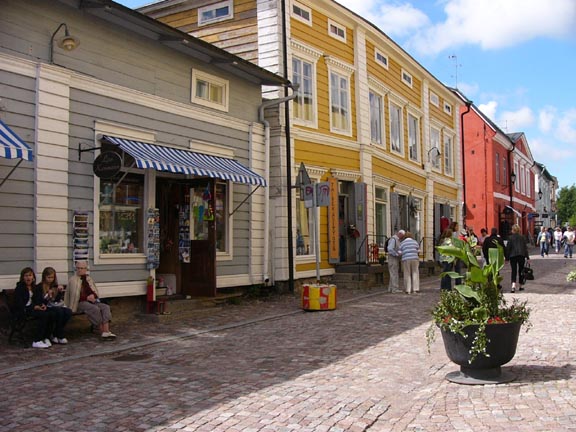
We
took a bus back to Helsinki from Porvoo. And the next day, headed north
on the train for the Arctic Circle....
|













